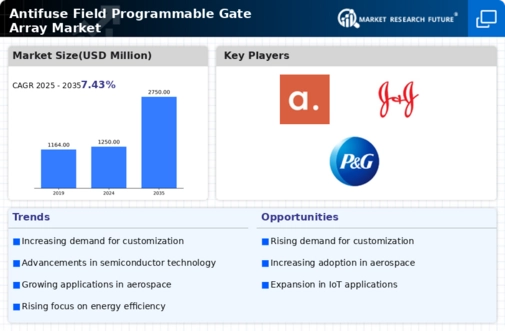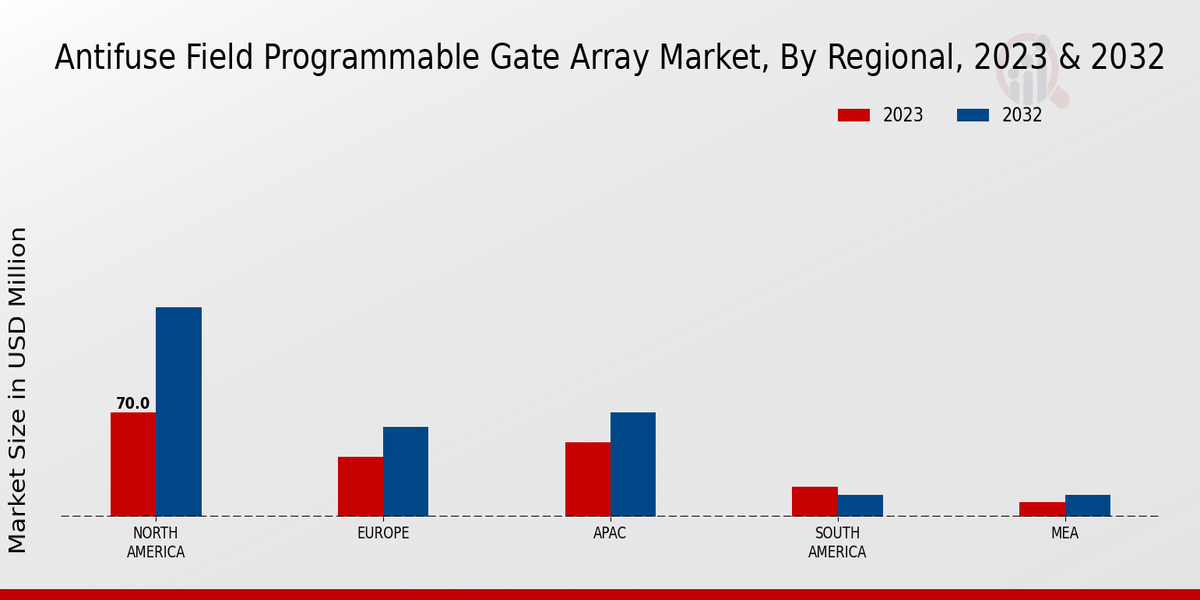Market Growth Projections
The Global Antifuse Field Programmable Gate Array Market Industry is projected to experience substantial growth in the coming years. With a market value expected to reach 1250 USD Million in 2024 and potentially 2750 USD Million by 2035, the industry is poised for a compound annual growth rate of 7.43% from 2025 to 2035. This growth is driven by various factors, including rising demand for customizable solutions, technological advancements, and increased adoption in sectors such as aerospace and defense. The market dynamics suggest a robust future for antifuse FPGAs as they continue to meet the evolving needs of diverse applications.
Increased Focus on Energy Efficiency
In the Global Antifuse Field Programmable Gate Array Market Industry, there is an increased focus on energy efficiency as industries strive to reduce operational costs and environmental impact. Antifuse FPGAs are recognized for their low power consumption, making them an attractive option for applications in IoT devices and portable electronics. As global energy regulations become more stringent, manufacturers are compelled to adopt energy-efficient solutions. This shift not only aligns with sustainability goals but also enhances the market appeal of antifuse FPGAs, potentially leading to increased adoption rates across various sectors.
Rising Demand for Customizable Solutions
The Global Antifuse Field Programmable Gate Array Market Industry experiences a notable increase in demand for customizable solutions across various sectors, including telecommunications, automotive, and consumer electronics. This trend is driven by the need for tailored applications that can adapt to specific requirements, enhancing performance and efficiency. As industries increasingly seek to integrate advanced functionalities into their products, antifuse FPGAs provide a viable solution due to their unique programming capabilities. The market is projected to reach 1250 USD Million in 2024, indicating a robust growth trajectory as companies invest in customizable technologies to maintain competitive advantages.
Growing Adoption in Aerospace and Defense
The Global Antifuse Field Programmable Gate Array Market Industry sees a growing adoption of antifuse FPGAs in the aerospace and defense sectors. These applications require high reliability and security, which antifuse technology inherently provides due to its non-volatile nature and resistance to tampering. As nations invest in advanced defense systems and aerospace technologies, the demand for robust and secure electronic components increases. This trend is likely to drive market growth, as companies seek to leverage antifuse FPGAs to enhance the performance and security of their systems, thereby contributing to the overall expansion of the market.
Technological Advancements in FPGA Design
Technological advancements in FPGA design significantly influence the Global Antifuse Field Programmable Gate Array Market Industry. Innovations in design methodologies, such as improved synthesis tools and enhanced simulation techniques, facilitate the development of more efficient and powerful antifuse FPGAs. These advancements enable engineers to create complex designs that meet the increasing demands for speed and functionality in modern applications. As a result, the market is expected to grow at a compound annual growth rate of 7.43% from 2025 to 2035, potentially reaching 2750 USD Million by 2035, reflecting the industry's response to evolving technological challenges.
Emerging Applications in Artificial Intelligence
The Global Antifuse Field Programmable Gate Array Market Industry is witnessing emerging applications in artificial intelligence and machine learning. As these technologies gain traction, the need for high-performance computing solutions becomes paramount. Antifuse FPGAs offer the flexibility and processing power required to support complex algorithms and data processing tasks. This trend is likely to drive innovation and investment in antifuse FPGA technologies, as companies seek to harness the potential of AI. The integration of antifuse FPGAs in AI applications could further propel market growth, reflecting the industry's adaptability to evolving technological landscapes.





